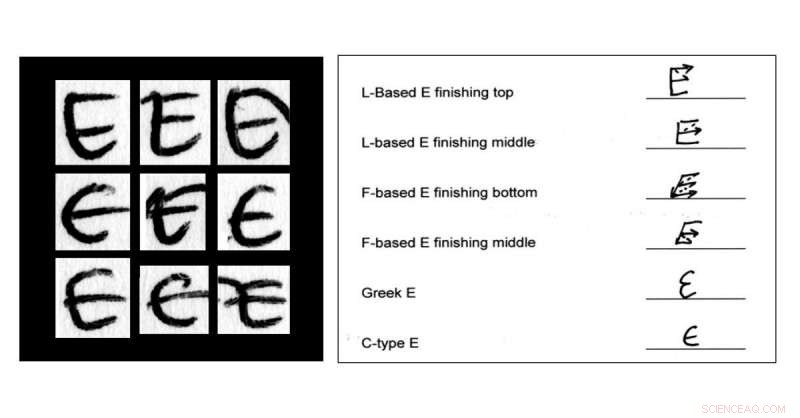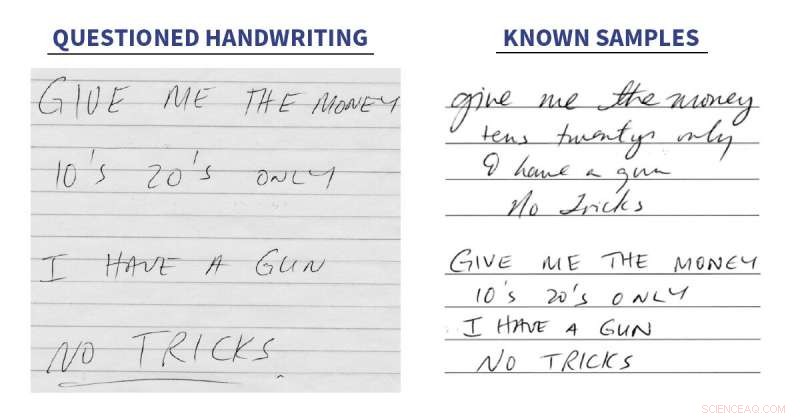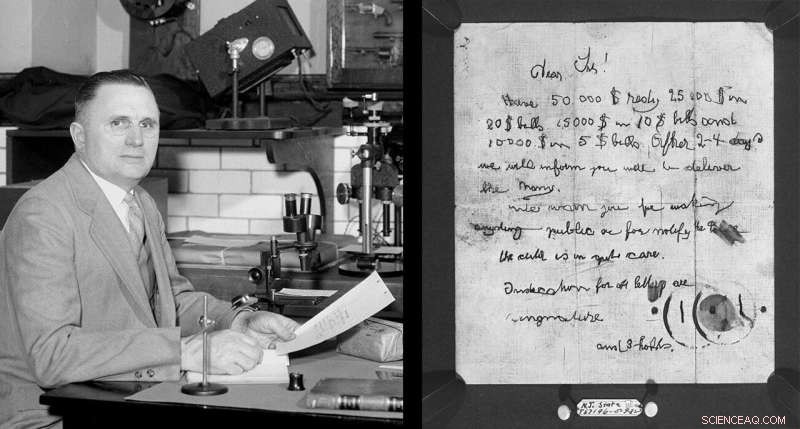
Uma gama de variação natural na letra maiúscula “E” de um escritor Crédito:NIST
As pessoas estão escrevendo mais do que nunca com seus teclados e telefones, mas notas manuscritas tornaram-se raras. Até as assinaturas estão saindo de moda. A maioria das compras com cartão de crédito não os exige mais, e se eles fizerem, normalmente você pode apenas riscar um com a unha. A antiquíssima arte da escrita à mão está em declínio.
Isso marca uma mudança profunda na forma como nos comunicamos, mas, para um grupo de especialistas, também levanta uma questão existencial. Os examinadores de caligrafia forense autenticam notas e assinaturas manuscritas - ou revelam que são falsas - analisando características distintas em nossa escrita. À medida que as pessoas escrevem menos à mão, o exame de caligrafia se tornará irrelevante?
Um relatório recente do Instituto Nacional de Padrões e Tecnologia (NIST) sugere que a resposta é não - se o campo mudar para acompanhar os tempos. Mas os tempos estão mudando em mais de uma maneira, e o declínio da caligrafia é apenas um dos desafios que o campo terá de enfrentar.
Como os especialistas fazem isso
Emily Will é examinadora de caligrafia certificada em consultório particular na Carolina do Norte. Ela examinou assinaturas em incontáveis cheques, testamentos, ações e relações de confiança. Ela inspecionou registros médicos para avaliar se a assinatura de um médico pode ter sido adicionada em uma data posterior à indicada, talvez depois que um processo foi aberto. Ela também examinou formas mais longas de escrita, como cartas de ameaça ou assédio e notas de suicídio. Se a aparente vítima de suicídio não escreveu a nota, a polícia pode ter um homicídio em suas mãos.
Para avaliar se uma peça manuscrita foi escrita por uma pessoa em particular, os examinadores precisam de algo para comparar, então eles coletam amostras de escrita que são reconhecidamente dessa pessoa. O tipo de escrita deve ser o mesmo, seja uma assinatura, letra cursiva, ou impressão manual. As amostras conhecidas devem ser aproximadamente do mesmo período de tempo que a caligrafia em questão, porque nossa caligrafia evolui com o tempo. E ter várias amostras conhecidas para comparar é fundamental, pois isso permitirá ao examinador considerar a variabilidade no estilo de escrita de uma pessoa.
"Você não é um robô, então cada vez que você assina seu nome, vai parecer diferente, "Will disse." Isso é o que torna o exame de caligrafia tão interessante. "
Os não profissionais podem pensar que, uma vez que a maioria das pessoas sabe como produzir caligrafia, praticamente qualquer um pode examiná-lo. Eles podem presumir que o especialista compare coisas como o tamanho, inclinação e espaçamento das letras e as conexões entre elas. De fato, examinadores fazem isso. Mas eles também olham além dessas características da escrita em busca de sinais mais sutis de como a escrita foi feita.
"Digamos que você queira forjar uma assinatura, "Will disse." Você pode ser capaz de executar um bom fac-símile. Mas o "O 'está no sentido horário quando deveria estar no sentido anti-horário? Existem elevadores de caneta onde não deveria? Quando você assina seu nome, é tudo memória muscular. Mas forjar uma assinatura requer deliberação. A caneta fica mais lenta. Ela para e inicia . " Essas hesitações aparecem ao microscópio como minúsculas poças de tinta.
"Não é tanto a aparência da assinatura, mas como foi executado isso é importante, "Will disse.
Aqui está o que Will carrega em sua bolsa:uma lupa de joalheiro, um pequeno microscópio óptico e um microscópio digital portátil. Uma lanterna. Um micrômetro de papel, para medir a espessura do papel. Um laptop e um scanner portátil. Uma câmera que se conecta a seus microscópios. "E francamente, " ela diz, "Eu uso muito meu iPhone atualmente."
A prática de Will se estende ao campo mais amplo de "exame de documentos questionados, "que envolve a análise de um documento inteiro em busca de sinais de fraude. Em seu laboratório, ela tem equipamentos para analisar papéis e tintas e visualizá-los sob diferentes tipos de luz. Algumas tintas que parecem idênticas à luz do dia parecem totalmente diferentes no infravermelho. Ela identifica rasuras, alterações e obliterações e revelam escrita recuada - as impressões deixadas nas folhas de papel abaixo da nota escrita.
Mas a maior parte do trabalho de Will envolve escrita à mão e assinaturas, e há muito menos deles atualmente. A fraude com desconto de cheques está diminuindo agora que os cheques de pagamento e da Previdência Social são depositados diretamente. Os processos por negligência médica envolvem menos assinaturas, uma vez que os registros eletrônicos de saúde se tornaram a norma. Até as celebridades notaram a mudança. Em um artigo de opinião de 2014 no The Wall Street Journal, Taylor Swift escreveu, "I haven't been asked for an autograph since the invention of the iPhone with a front-facing camera."
Enough handwriting still passes under Will's microscope to keep her in business. Mas, ela diz, "If I were a young person starting out today, I might consider cybersecurity."

Forensic handwriting examiners can only compare writing of the same type. Nesse caso, only the second known sample can be compared to the questioned handwriting. Credit:NIST
A Roadmap for Staying Relevant
The field of forensic handwriting examination may have trouble attracting new blood. A report from NIST earlier this year found that the median age for handwriting examiners is 60, compared with 42 to 44 for people in similar scientific and technical occupations. Esse relatório, Forensic Handwriting Examination and Human Factors:Improving the Practice Through a Systems Approach, was published by NIST, but was written by 23 outside experts, including Will.
To increase recruitment, the report recommends replacing the unpaid apprenticeships that have been the traditional route of entry into the field with grants and fellowships. The report also recommends cross-training with other forensic disciplines that involve pattern matching, such as fingerprint examination.
The "human factors" in the report's title refers to a field of study that seeks to understand the factors that affect human capability and job performance. In forensic science, these include training, comunicação, technology and management policies, para citar apenas alguns.
Melissa Taylor, the NIST human factors expert who led the group of authors, said that the report provides the forensic handwriting community with a road map for staying relevant. But the threat of irrelevance doesn't come only from the decline in handwriting. Part of the challenge, ela diz, arises from the field of forensic science itself.
"There is a big push toward greater reliability and more rigorous research in forensic science, "disse Taylor, whose research is aimed at reducing errors and improving job performance in handwriting examination and other forensic disciplines, including fingerprints and DNA. "To stay relevant, the field of handwriting examination will have to change with the times."
Among other changes, the report recommends more research to estimate error rates for the field. This will allow juries and others to consider the potential for error when weighing an examiner's testimony. The report also recommends that experts avoid testifying in absolute terms or saying that an individual has written something to the exclusion of all other writers. Em vez de, experts should report their findings in terms of relative probabilities and degrees of certainty.
These recommendations are consistent with findings in a landmark 2009 report from the National Academy of Sciences. Called Strengthening Forensic Science in the United States:A Path Forward, that report said that "there may be a scientific basis for handwriting comparison, " but that there has been only limited research on its reliability.
Knowing When to Not Make a Call
Children used to learn handwriting in school by copying letters and phrases from books that contained models of ideal penmanship. Different copybooks had different styles, and an expert could often tell from a person's handwriting whether they were trained in the Palmer style, the Spencer style, or something else. By identifying a specific copybook style, an examiner could quickly narrow the range of potential writers.
Many children no longer learn cursive writing in school, and whether this helps or hinders handwriting examination is unknown. "It might actually make handwriting more identifiable because it allows people to develop their own individual styles of writing, " said Linton Mohammed, author of the widely used textbook Forensic Examination of Signatures, and a co-author of the NIST-led study.
Por outro lado, it might make the task harder by depriving experts of a system for classifying writing styles. This is one reason why research on error rates is needed. The way people learn to write has changed, and error-rate studies can show whether handwriting examiners are successfully adapting to those changes. "We claim to be good at this, " Mohammed said. "But how good are we really?"
Several studies have attempted to answer this question by testing whether experts are more competent at handwriting examination than people with no training. The results reveal a great deal about both handwriting examination and human psychology.

In the 1930s, a physicist at NIST, then known as the National Bureau of Standards, became a leading handwriting expert. His name was Wilmer Souder, and the most famous case he worked on was 1932 the kidnapping of Charles Lindberg Jr., the infant son of the famous aviator. Despite the notoriety of this case, Souder himself kept an extremely low profile — so much so that when he retired, a profile in "Reader's Digest" referred to him as Detective X. Credit:NBS/NIST; source:NARA
In many of these studies, participants are shown pairs of signatures and asked to determine whether they are both by the same person or if one is a fake. Calculating overall error rates from multiple studies is difficult due to differences in study design. But consistently, across studies, both experts and novices made roughly the same proportion of correct decisions, according to a 2018 metastudy led by Alice Towler at the University of New South Wales, Austrália. The novices, Contudo, made a much higher proportion of errors, while the experts more frequently declined to make a call. If a signature lacked complexity or was otherwise difficult to compare, the experts would more readily find the evidence inconclusive. This ability to defer judgment is critical to reducing errors in forensic science.
The tendency of novices to rush to judgment in cases where experts defer reflects a quirk of human psychology. People with limited knowledge or expertise in a subject often overestimate their own competence. This is called the Dunning-Kruger effect, for the psychologists who first described it. In the case of handwriting, people might be particularly susceptible. Afinal, pretty much anyone can produce handwriting. How hard can it be to examine?
But error rate studies show that at least some experts recognize their limitations when faced with a difficult task. "I've been doing this for 30-plus years, and I realized early on that there's a lot that we don't know, " Mohammed said. "So we have to be very careful in reaching our conclusions."
The End of Handwriting Examination, or a New Beginning?
Like Emily Will, Mohammed has examined many wills, deeds and trusts. He has also analyzed ransom notes, threatening letters, and one hit list. Being based in the San Francisco Bay Area, where the tech boom has minted many fortunes, he has also examined many stock-option grants and prenuptial agreements.
Although Mohammed started his career with the San Diego County Sheriff's Department, today he is in private practice. In his current home base of northern California, he says, there are no government laboratories that still examine questioned documents. This reflects a nationwide trend—a report from the Department of Justice found that only 14% of publicly funded crime labs did their own questioned document examinations in 2014, down from 24% in 2002.
Those numbers may mean that the field is consolidating rather than disappearing. If smaller labs can no longer support in-house experts due to a diminishing caseload, they can farm out work to private sector experts like Will and Mohammed. Ao mesmo tempo, larger federal labs, including the FBI Laboratory and the U.S. Army's Defense Forensic Science Center, continue to maintain questioned document units. This is in part because their focus includes international terrorism, where handwritten documents are still a source of valuable intelligence, and in part because the United States is a big place. Em todo o país, crimes involving handwriting still occur frequently enough that federal labs need to keep experts on staff.
When asked if handwriting examiners will soon become irrelevant, one federal expert said that as long as greed and fraud exist, there will be a need for handwriting examiners.
When asked the same question, Mohammed noted that changing technology did not doom the field in the past. "When the ballpoint pen came out, people said, "That's the end of handwriting examination, '" he said. People mostly stopped using fountain pens, but handwriting examination survived the transition.
Melissa Taylor, the NIST expert, agrees that handwriting examination is still a needed skill and will remain relevant—if the field successfully adapts to changing expectations around research and reliability. And if the new report, which counts many leading handwriting experts among its authors, is any indication, the needed changes may already be underway.
"There will still be documents. There will still be signatures, " Taylor said. "And most people don't print stickup notes on their laser printer. They scribble them on the dashboard before running into the bank."
Some things will never change.